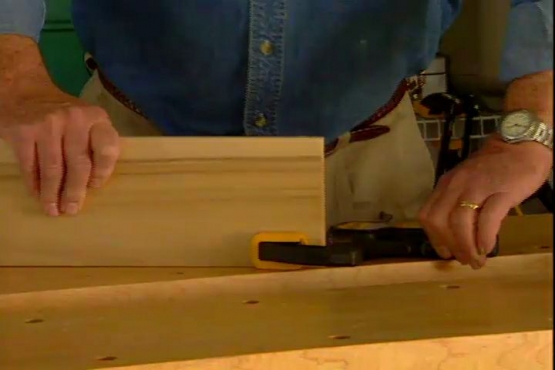RON HAZELTON:
This 35 year old Ash tree in my front yard is kind of like an old friend. But sad to say, it's been quite sick for a while. And my tree expert says it's really too far gone to save. So reluctantly I've decided to have it taken down.
And Rich Ferrara is the guy to do it. Rich loves trees and I think he's as comfortable hanging off a rope 50 feet in the air as he is standing on solid ground. His first task is to cut away several large branches on the side of the tree that will strike the ground first.
He does this to minimize the damage when the falling tree hits my lawn. To further protect my grass, he lays several cut off limbs side by side. Next Rich makes a wedge shaped cut on the direction he wants the tree to fall. Then saws a second cut on the opposite side.
These cuts plus a guideline allow him to drop the tree exactly where he wants it. As you can see, the limbs he put down earlier have kept the tree from burying itself in my turf. While Rich and his helper start trimming off and grinding the smaller limbs and branches, I mark cut lines on the trunk.
I may have lost my tree but I've come up with a way to remember it. Well my tree's gone and I don't feel too good about that. But I was able to salvage the trunk. And you know what, I'm going to have this sawn into lumber using this portable saw mill.
Dave Scott has been a sawyer for more than 20 years. Today he and his partner, Kyle Cheeley are about to turn tree trunks into timber right here on my front lawn. This tool is essentially a really big band saw that travels back and forth on a rail.
We start by making 2 cuts off the top of the log. In a way it's like opening an oyster in search of a pearl.
[BOTH SPEAK AT ONCE]
But it's a surprise. Every board is a surprise.
DAVE SCOTT:
Every log, you just never know how it's going to open up. This is very pretty if you look over around this one, one knot.
RON HAZELTON:
This is very nice indeed. It's beautiful and it's sound too. Dave rotates the log a quarter turn and we start cutting the second side. This time I'm at the controls. After each pass, I lower the saw blade anywhere from an inch and a quarter to an inch and a half depending on how thick I want the boards. After one more turn, we're about to reduce our once circular log to a rectangular beam.
Finally we clamp several of the boards into the mill bed vertically. So we can cut away the bark and end up with a straight edge. Now out of that single log, I got all of this lumber and only that small amount of scrap. That's why they call that saw mill the wood miser.
Well my tree has gone from logs to lumber. But before I can build anything out of this, I've got to dry it. Now the ends of a plank dry out more quickly than the center. So I'm applying some latex paint to slow down the drying on the end.
And prevent cracking which could cause me to lose some really useful lumber.
[MUSIC]
Now these small pieces of wood right here are called stickers. I've put them between each of the planks. Now that's going to create a space in there that will allow air to circulate and cause the boards to dry evenly.
Now I've stacked the stickers right on top of each other to prevent any of the boards from bowing and I started out by putting the bottom boards on a level surface made up of these 4 by 4s down here. But right now, the whole idea is to dry this lumber without cracking, warping or splitting.
Now that's going to take a few months. In the meantime, I can figure out what I want to make out of it. How about a doghouse?







